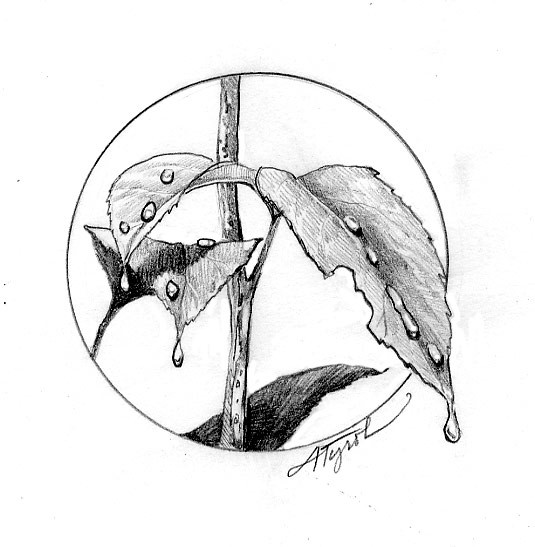
The shape that tree leaves take is mostly an adaptation to shade and sun; leaves are tailored to optimize the production of food and oxygen under conditions that range from parched desert to lush rainforest. After all, that is the primary purpose of leaves: to feed the tree. But there is more to leaf shape than just providing food, and that is water control.
Wherever trees grow, it rains – heavily, or rarely. Whenever a raindrop strikes a hard surface, even a yielding one like a leaf, it shatters. Large water drops are split into smaller, spray-sized droplets when they land on a leaf, and their impact upon the ground is dispersed and gentler than the concussion of heavy drops falling unimpeded. In densely vegetated land, there is less erosion and loss of soil than on surrounding unforested countryside. Although plant roots play a key role in this, the ability of leaves to disperse the rain’s energy is important, too.
“Leaf-shape” usually implies a lance-like shape, whose narrow end is sharp and pointed like the head of a spear. This is a generalization that applies to most leaves, despite their endless variations in shape – round, lobed, toothed, and more. Perhaps simple lanceolate blades were the original, ancestral shape of all leaves, for it’s doubtful that the earliest leaf-like structures were divided into lobes or were compounded into other complex forms, despite such shapes appearing later in the fossil record as trees evolved. Endless varieties of lanceolate leaves are common today, and the emergence of an embryonic, blade-shaped leaf erupting from a stem’s leaf bud seems to be the least complicated of beginnings.
Raindrops falling on a leaf not only break into smaller droplets but also are channeled down the leaf’s waxy surface, mostly along the midrib’s crease, although lateral veins may carry some as well. This is especially easy to observe in a lanceolate leaf. Under the weight of accumulating moisture, a leaf droops further until water falls off the pointed end at what is called the drip tip. In more complex, compound leaves, there may be several drip tips, or points, one to each pointed lobe. Highly specialized, very narrow leaves packed close together in great density, such as those of conifers (called needles), provide a multitude of drip tips.
What do drip tips do? They enable leaves to shed water more quickly. Most studies of the drip-tip effect have been made in the tropics, where lanceolate leaves are common and more exaggerated than those of the trees in Vermont and New Hampshire. Some leaves have long, drawn-out, spigot-like tips that provide fine, steady streams during heavy rain. I’ve used them to quickly fill a canteen. Cut off the drip tip, and the leaf suddenly holds three times the amount of water because its system of quickly shedding rain has been interrupted. The water no longer collects on the drip tip, the weight of this collected water no longer bends the leaf down as far, and rainwater starts to pool on the leaf before it deepens enough to spill over the edges.
Drip tips have other benefits of immediate importance to a tree. Flushing water off a long, drooping tip means a leaf dries quickly, its upper water-repellent epidermal surface returning to a condition favorable for the penetration of sunlight. Rapid drainage also dislodges dust and debris that otherwise might shade light from entering chlorophyll-containing tissues of leaves. Damp foreign material remaining on a leaf surface encourages the growth of epiphytes and fungi, but drained of moisture, a leaf is less susceptible to these harmful organisms.
Leaf shape and drip tips are essential features of tropical plants, where rain typically falls as a deluge. On volcanic islands, heavy tropical downpours quickly erode thin soils, and with less soil and little groundwater, winds topple trees. Trees such as the Hawaiian koa come to the rescue. With its tens of thousands of “leaves” (actually enlarged, sickle-like stems that substitute for leaves), each giant koa provides tens of thousands of distinct drip points, which gently disperse the showering cascade over a wide radius where it can safely soak into the soil. Erosion is greatly lessened, creating perfect conditions for the other plants and animals of the native forest.
The situation is far less extreme in Vermont and New Hampshire, where most of our annual rain comes in regularly spaced, smaller quantities. But the general principles of leaf shape still apply. On the one hand, leaves need to be strong yet supple to dispel the energy of incoming rain without breaking. On the other, they need to drain quickly to avoid being weighed down by rainfall or inadvertently playing host to suffocating fungi. Just something to think about at this time of year, when you’re admiring the foliage.

